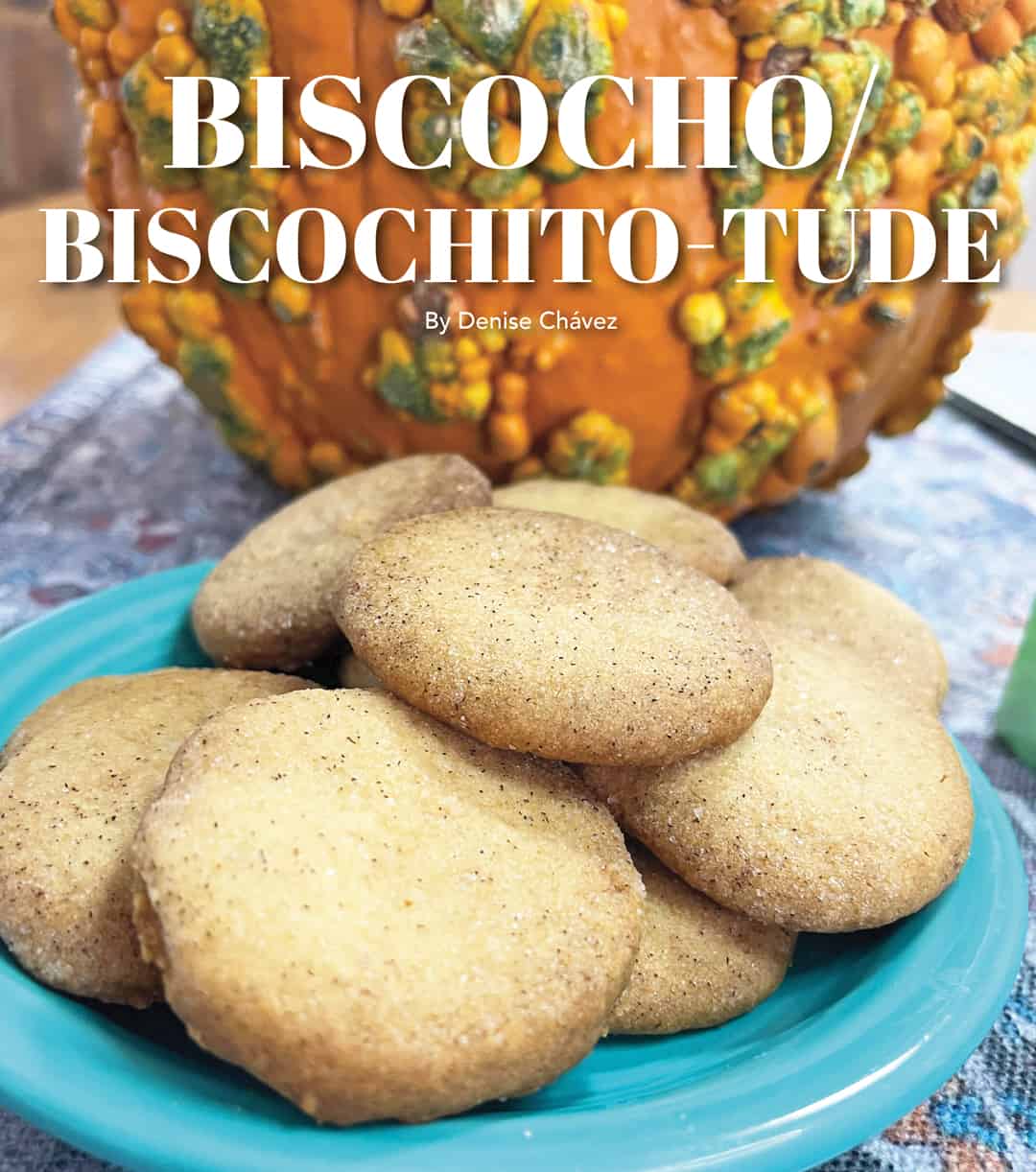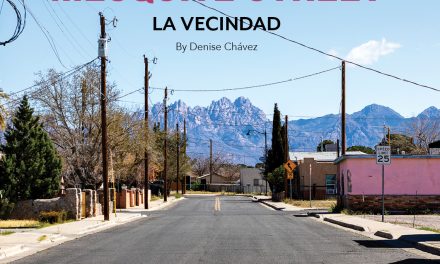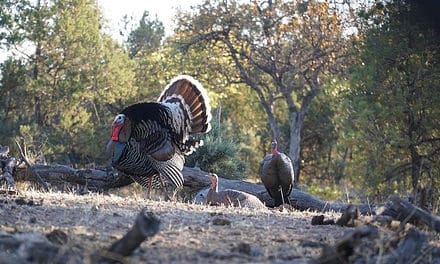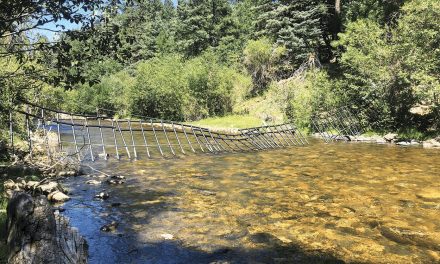
Biscochos and photo by Bernardine Baca Spiers.
“Who cares about the name, it’s still the same delicious official cookie of New Mexico. Of course, I’m going to tell you my mom’s were the best.” —Armando Maynes Jr.
The real question in New Mexico is not Red or Green, but Lard or No Lard? This article is not about whether you prefer red or green chile but what you know, understand, and love about our official state cookie.
It is interesting that New Mexicans have such a strong love of biscochos/biscochitos. Only two other states have state cookies: Massachusetts’s is the much loved and most preferred cookie in the United States, the chocolate chip cookie, and Alabama’s is the lesser-known Yellowhammer, a sandwich cookie.
But let’s start at the beginning. Is the name of the cookie biscocho or biscochito? Is it spelled bizcochito or bizcocho? I don’t have the time or the inkling to get into the universal ramifications of what a biscocho is—whether it is a sponge cake from Spain; a biscoito de huevo, the Sephardic tea biscuit again from Spain; the twice-baked bread from the Philippines; or what some call a Mexican wedding cookie, covered in powdered sugar.
I am talking about the New Mexican cookie, loved by so many, that is usually rolled in sugar and cinnamon, and that may or may not include whole, ground, or liquid anise, usually incorporating lard. The dough might also include a pinch of salt, whole eggs or just the yolk, cinnamon or orange rinds. The wildly adventurous may well include raisins or pine nuts. Some use orange juice or Mogen David wine or anise liqueur or rum, and some use just plain water. In my family, my mother, Delfina, used pineapple juice to give the cookie a distinctive sweetness. Just how distinctive do you want to be? This cookie accepts it all.
This fall, I conducted a poll on Facebook and the Biscocho/Biscochito-tude grew to gigantic proportions. The commentary, its liveliness and sometimes ferocity, became as complicated, rich, and culturally complex as our beautiful state. I never imagined the responses would be so hearty, heated, eclectic, and so deeply moving. Friends and followers from northern and southern New Mexico, and all points east and west, responded. In the state of Michoacán, the cookie is called a galleta, and in Sonora a biscochuelo.
In my family in and around Las Cruces, the cookie was called a biscocho. Friends report that once they moved north, the name changed to biscochito because that was the vernacular, and they were told biscocho referred to a part of the female anatomy. I had heard this, and wondered where this linguistic shift began.
As a writer, I am interested in all the vagaries of our New Mexican culture, and that includes our language, our food, and how a word for food can be one thing in the north and another thing in the south. Was the root word of Mexican or Spanish usage? There is a difference, and I really don’t want to get into the north/south debate, as that would take a book. Let’s just stay with our state cookie.
Do you crumble the anise or use it whole? Saundra Salas-Guest says her mom started using anise extract because she didn’t like the seeds getting in her teeth. Friend Victor Sandoval bemoans the fact that anise isn’t what it used to be. “I have found recently that the anise seed one buys today is not as tasty as they were. I can’t bake my biscochitos to taste enough like licorice.”



Top left: Dr. Erlinda Gonzales-Berry’s biscochitos. Bottom left: Denise Chávez’s biscochos. Right: Mancha-covered recipe.
My mother had a battered old cookbook that I still use. The pages are food smeared, covered with telltale manchas, spots, where a piece of dough landed or water splattered. I treasure this cookbook as many do their mother’s and grandmother’s cookbooks, their recipes copied down on ragged pages of paper and in old notebooks. Our lineage is food. We know who we are from what we eat and who made it and provided it for us.
This legacy and ritual of story comes down to us in many ways: Who were your parents, where did you grow up, what were your traditions, and how did they impact your life? These sacred customs were passed on from family member to family member. Don’t you mess with that anise! Lard, but of course! There were occasional forays and inventive and creative and sometimes necessary additions to a recipe that completed and made things better, this is for certain.


Left: Ana Cordova’s recipe. Right: Paula Yvette Martinez’s biscochos.
My first poll respondent was Dr. Erlinda Gonzales-Berry, retired professor at the University of New Mexico, who grew up in northern New Mexico and is now living in Oregon. She shared this biscochito memory:
Every Christmas we broke out the flour, sugar, and anise and set about to make biscochitos. Mom mixed and rolled the dough, and we helped her cut the cookies. We cut small squares, then little slits on one edge. We call these the little toes. We then dusted them in sugar and cinnamon and into the oven they went. The trick was to roll them very thin so they would turn out delicately and delectably. We couldn’t stand Grandma Pole’s version because they were fat, ungainly, and downright indelicate. That’s why we called [ours] biscochitos. Biscochos were everything biscochitos weren’t, so never, ever, did we call our lovely cookies biscochos.
When I returned from California after a two-year stint teaching school, I brought back modern ideas. For example, rather than creaming the lard and sugar by hand, which took hours of heavy labor (usually done by Dad), we taught my parents to use the hand mixer. And I bought cookie cutters (Christmas tree, stars, and other Christmasy designs) and little toes fell by the wayside. Years later, as I studied everything I could get my hands on related to la cultura nuevomexicana, I came across the following on biscochitos: the cookies were cut in the shape of the Spanish crown. Ergo the little toes! . . . From that moment on, I returned to making my biscochitos with little toes and taught my daughter to do the same. So every year at Christmas, we break out the ingredients, and we set about repeating a centuries-long cultural practice. No high falutin’ modern adaptations—well, except for creaming with the electric beater.
Everyone is a storyteller when you start talking about food. Especially food you love and that has sacred meaning to you. The stories that emerged from my Biscocho poll tumbled out and came hard and fast.

Gonzales-Berry’s biscochitos.
I learned from Victor M. Macías-González, originally from El Paso, Texas, that convents in Spain and Mexico heat their lard first, just as his abuela used to do and his family still does today.
I have never put salt in my biscochos and learned that many do. Nor have I ever added an egg, either the yolk or the whole. Each recipe that came in gave me an impetus to learn more. I want to try out each one. I am eager to use piñóns, our beloved pine nuts, included (along with raisins) in a recipe from Casida Gonzales. Her family was originally from New Mexico, and she shared her recipe with some reticence, worrying that her version might offend the tried and true.
So when does one make our dear cookie? For many, it is a traditional and loved Christmas standard. It is also enjoyed at weddings, anniversaries, birthday parties, and after a good meal at home or at your favorite Mexican or New Mexican restaurant. California poet Marisol Baca remembers her grandmother and auntie baking forty-
two dozen cookies for her wedding. Now that was a feast!
I once made double-digit numbers for my beloved Tío Sammie’s anniversary and delivered them the next street over in a state of overheated Biscocho-tude, the likes of which are often seen in our biscocho-loving state.
The gift of cookies is a treasure to anyone. It is like that unexpected loving letter that comes in the mail that says you are special and, yes, loved. I am always grateful for a gift of a cookie. My father’s favorite store cookies, pecan sandies, stir memories, as does the family biscocho.
Connie Chacón and her husband ruminated about the biscochitos that her niece sold in Wyoming. They found it interesting the individuals who bought them had family connections to New Mexico, some with parents or grandparents who had moved to Wyoming as sheepherders or settled there to work on the Union Pacific. It is true that if a displaced out-of-state biscochito lover speaks out, they always remember and voice those family ties. The cookie links them to home.
For neophytes who would attempt a biscocho, attention must be paid. The thing about biscochos/biscochitos is that, like all food, they have their fine points. Listen up, then. You need to approach the preparation and baking with respect and time. You cannot hurry a biscocho.
The consensus is that lard is a must. As Paula Chávez-Talley from Albuquerque says, “Team lard, all the way.” Remain calm. You will have to determine this for yourself, but listen. It is recommended. And I am a vegetarian (for the most part). The use of lard in the recipe is a critical detail and has and will continue to divide families, friends, nations. Lard? Them’s fighting words.
Anise or no anise? I say anise, but then again, I am a southern New Mexican who uses lard and says biscocho.
The thickness of the cookie is crucial. Do you want them tostaditos or regular? I have burned many cookies because of lax stove presence and have learned to take them out of the oven before they appear to be done. The more batches you cook, the hotter the oven will get, so be prepared to camp out in the kitchen during biscochito season.
Some cooks sprinkle the sugar-cinnamon mixture on the cookie before cooking. I recommend doing it after the cookie has cooled for a while. You cannot take a freshly baked cookie and turn it in the sugar-cinnamon mixture, or it will break or crumble. You cannot wait too long either, or the sugar mixture will not adhere. Again, timing is of the essence.
How do you cut your cookies? Many families have their revered cookie cutters, passed down from their grandmothers; others use a knife to make free-form triangles. I have used my mother’s set of playing card cutters, once a popular item, to make cookies in the form of hearts, spades, clubs, and diamonds. I have tried to vary the shapes, once trying out an Eiffel Tower cutter in honor of my husband’s French ancestry. My recommendation: don’t go vertical. The biscocho will be fragile to bake and handle. Be inventive as you wish and, yes, the designs are myriad, incredible, fun. But I always go back to the basic forms.

Liz Maldonado’s biscochos.
When reviewing my family biscocho recipe and comparing it to the many I read and reviewed, I am in awe of how very basic it is. I like it that way. Maybe that’s why it’s so good to me. The simplicity of the known and loved.
The cookies preserve well—that is, if you can keep yourself from eating them. I keep mine in a metal tin in the refrigerator.
At the Hispano Chamber of Commerce gala earlier this year, I was seated at the back of the room, the eagle’s roost table, always full of interesting loners and last-minute, stay-in-the-back types. At the same big round table were Miss New Mexico, her mother, a very dynamic and gregarious priest from down in the valley who gave the prayer before eating, and a woman furiously fanning herself, her husband fanning her as well (“It’s that time of life,” she stated).
I asked Miss New Mexico’s mother about biscochos and she gave me her family’s recipe almost apologetically: a no-bake cookie made with Mexican Marías, condensed milk, and powdered sugar. It sounded good. Hardly a biscocho in my mind, but then again . . . a biscocho is a biscochito is whatever you know or want it to be.
To give a true perspective on our love of our official cookie, some Decembers ago I decided to make biscochos. But when I went to the grocery store there was a run on lard. None to be found here, there, anywhere! When there is hurricane weather in Florida, there are often no candles or batteries to be found. Only in New Mexico will you find a shortage of lard! I thought of making a trip to El Paso to International Lard to stock up but ended up calling my cousin Darlene, the best baker in the family. She saved my life and handed over a small precious packet of Morrell lard. Christmas was saved!
All things come together with a biscocho. For a moment in time, things remain tranquil and good, a nearby cup of café or a glass of milk or better yet, un vinito, a little wine, an assurance that all is well, all is as it should be, that in the next room is family, that you will soon be joining all those in spirit or in person, the living, the dead, the ancestors, the new friends, the neighbors, the generations all in the same place, children running around joyfully, a nearby animal vying for attention and a morsel of something to eat, abuela and abuelito in their favorite spots ready to enjoy that tradition that signifies belonging. Así es. That is how it is.
Nuevo Mexicanos north, south, east, and west, and almost anyone else who has ever tasted our official state cookie, love it. Biscocho. Biscochito. Bizcocho. Bizcochito. No matter what you call it, it will always be New Mexico, always be family, always be home to anyone who reveres our beautiful land. To my sister, Margo Chávez-Charles, a biscocho means Mother.

BISCOCHOS: CHÁVEZ FAMILY RECIPE
(excerpted from A Taco Testimony: Meditations on Family, Food and Culture by Denise Chávez)
- 1 pound pure lard; Morrell is good
- 1 cup water, or pineapple juice for extra flavor
- 1 cup sugar
- 1 tablespoon cinnamon
- 1 tablespoon whole anise seed
- 7–8 cups flour
Cream the lard, add water or pineapple juice, and cream together until practically all liquid has been absorbed. Add sugar. Cream the mixture until it is smooth. Add cinnamon and anise. Add flour until the mixture is stiff enough to shape by hand. Pat, then roll gently to about 1/4 inch thick. Cut into small cookie shapes. Bake until brown, about 15 minutes, in a 350°F oven, checking that the bottoms do not burn.
Let cool slightly. Sprinkle cookies with cinnamon and sugar, then turn them in a pan containing a mixture of cinnamon and sugar.
FROM THE BISCOCHO/BISCOCHITO POLL

Bernardine Baca Spiers’ biscocho recipe being rolled out.
What does a biscocho mean to you?
Family. It’s my kids, my sister, and friends gathered in my kitchen mixing, laughing, using the cookie shooter to make all kinds of biscochos. The aroma of anise engulfing my home. It is my husband having the honor of the first taste. The best part, packing the cookies in containers and delivering them. We decorate a wagon, dress up my chihuahua dog, Papi, crank up the Christmas songs, and deliver cookies to our wonderful neighbors. —Liz Maldonado
Have you made biscochos?
Yes. After graduating college one of the things my mother gave me was Historic Cookery by Fabiola C. Gilbert. That was fifty years ago, and I still consider this forty-three-page cookbook a seminal work on New Mexican cooking. I use the bizcochitos recipe on pages 29–30 with the following modifications: I roll the dough 1/4 inch thick. I submerge the warm baked cookies in a cinnamon sugar mixture that is heavy on the cinnamon (1 1/2 tablespoons cinnamon to 1 cup of granulated sugar). The first time I made them, I used cookie cutters that were the symbols on cards—spade, club, diamond, and heart. At Christmastime I like to make star and bell shapes. —Helen Beggane
Lard or no lard?
Yes, lard usually. I will use half or all Crisco to make them “healthier,” but the flavor and texture is not the same. I figure a little lard once a year or so won’t hurt too bad. —Mónica Córdova
I make them only with LARD. My family has always served them at Christmas with port wine. Family members fight for the biscochitos that are a little burnt. —Bernardine Baca Spiers
Can you share a biscocho memory?
My grandmother kept the cinnamon/sugar mixture in a diner-style sugar dispenser that had flower designs cut into the glass. The bottom had a flower too. When she made biscochitos, she would pour the cinnamon sugar into a dish, roll the dough, roll it in the sugar, then stamp it with the sugar dispenser. When she passed, that was the first thing I looked for in her house. It just holds sugar now, but it lives in my kitchen on display. —Ana Córdova
Toncha Álvarez attended my fiftieth birthday party. Toncha remembered the bizcochos that were my favorite from when we worked at La Posta Restaurant at the same time in 1975–82. She baked me a few dozen for my birthday gift. Very few presents in my life have been as memorable. Lovely to be remembered and lovely to enjoy delicious bizcochos. —John McDowell
I will always think of my father picking up a rolling pin a couple of years after my mother died to keep the tradition going. Everyone is happy to see him arriving with a tin of cookies in his hands. —Kathleen Jiménez
Were biscochos part of a family ritual? Who intiated that ritual and what does it mean to you?
My mother was always the matriarch and she would make the biscochos and the three daughters would help. She is now ninety-two years old, and I have become the matriarch of the family. As the youngest daughter, y la traviesa, I never really paid much attention. Now I have had to research the recipes and had my mom tell me all the ingredients. It is kind of frustrating because she says, “Échale un puño.” What the heck is that? A cup, a teaspoon, a lot of trial and error! Needless to say, all holidays, birthdays, social events are now at my house with me cooking. It is my honor to step in for my mom and now my kitchen is named “Camila’s Kitchen” in honor of my beautiful ninety-two-year-old mom that I am so lucky to have come over almost every Sunday. —Liz Maldonado
Thanks to everyone who has taken the poll, submitted comments, or stopped to remember and celebrate. If you didn’t and would like to, contact Denise Chávez at comezon09@comcast.net.
CLASSIC NEW MEXICAN COOKBOOKS
- The Good Life: New Mexico Traditions and Food, Fabiola Cabeza de Baca Gilbert
- Historic Cookery: Authentic New Mexican Food, Fabiola Cabeza de Baca Gilbert
- A Family Affair: A Few Favorites of Mrs. Griggs, Josephine C. Griggs and Elaine N. Smith
- La Posta Cook Book, Katy Camúñez Meeks
- New Mexican Dishes, Philomena Romero
- Original Native New Mexican Cooking, Yolanda Ortiz y Pino
- Southwest Flavor: Adela Amador’s Tales from the Kitchen, Adela Amador
- Recetas del Valle, Maggie Gamboa

Denise Chávez
Denise Chávez is a writer and owner of Casa Camino Real bookstore in Las Cruces. She is the author of The King and Queen of Comezón; A Taco Testimony: Meditations on Family, Food and Culture; Loving Pedro Infante; Face of an Angel; and The Last of the Menu Girls, among other works. Chávez is the winner of the American Book Award and the New Mexico Governor’s Award in Literature. Her long-term project, Museo de La Gente / Museum of the People, is the formation of a community resource center, library, bookstore, and living archive of the Borderland region based in her hometown. After all the hullabaloo, she has decided to write a book called Biscochos/Biscochitos: The Cookie.











